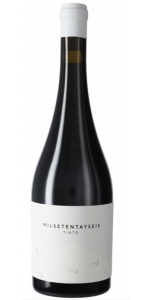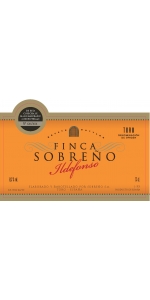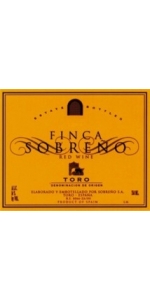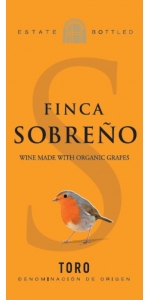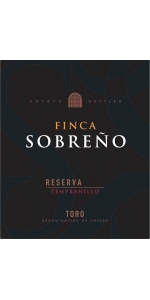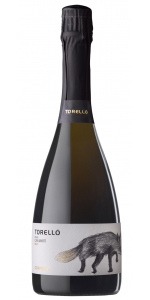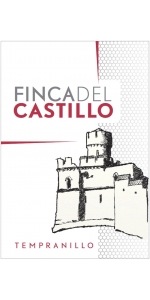Finca Sobreno Ildefonso Toro 2016
6 bottles with free shipping for: $294.00
12 bottles with free shipping for: $540.00
| BUY MORE! SAVE MORE! | ||||||||||||||||||||
|
| Country: | Spain |
| Region: | Toro |
| Winery: | Sobreno |
| Grape Type: | Tempranillo |
| Vintage: | 2016 |
| Bottle Size: | 750 ml |
Finca Sobreno Ildefonso Toro is made from 100% Tinta de Toro
Very Old Vines (Minimum 80 years of age)
Aged in 100% new French Oak Barrels for 18 months + 12 months in the bottle
The wine is produced in very limited quantity from the estate's oldest vineyards (80 years old vines) and is fermented in 2,000-liter open-top fermentation vats. Our winemaker punches down the cap by hand three times a day using the traditional pigeage method to ensure optimal extraction.
The name of the wine is the surname of the San Ildefonso family, father Roberto and daughter Paloma, and represents the apex of their winemaking tradition.
Tasting notes
Deep cherry color.
Very expressive, elegant and complex with ripe fruit, mineral notes, sweet spices, chocolate aromas and intense toasts.
Powerful, tasty, round and very smooth. We find again black berries, mineral notes, chocolates with roasted aromas. Very long after taste.
Soil types:
The soil is formed by sediments of sand, clay and limestone, which produce a dark lime-bearing topsoil, with fine and coarse sands.
This year we had low rain falls getting very healthy bunches. Besides, cool nights and not very hot days at the end of the cycle were excellent for a complete ripening of the grapes, full of nuances.
Winemaking and aging
The fruit is manually selected and picked in small cases. After destemming the grapes are stored in 2.000 liter open fermenter tanks and cold maceration at 8ºC during 8 days. Three times a day the cap of the skins is submerged manually (pigeage) and after the alcoholic fermentation is finished at a controlled temperature, the wine is macerated until the wine maker determines the appropriate extraction polyphenols. The malolactic fermentation is carried out in new French oak barrels. The wine was aged in new French oak barrels for 16 months, followed by another 12 months minimum in the bottle.
Ideal for red meats, lamb, roasted meat and strong cheeses
Review:
Black fruit and power from lots of new flashy oak. Coconut, coffee and mocha flavours; ripe and soft palate with an earthy texture. Long finish.
-Decanter 93 Points
The Finca Sobreno Estate
In the early 90's, a group of Rioja winemakers became interested in Toro, convinced that top class wines could be made from the local Tempranillo clone known as Tinta de Toro. The combination of Rioja know-how, modern technology, strict attention to detail and fine old-vines plantings has led Bodegas Sobreño to almost instant success in Spain and on the international scene. Bodegas Sobreño was founded in 1998. Just 7 years later, Bodegas Sobreño has become one of the best-known wineries in the region. The winery owns 1,400 barriques (primarily American oak) and boasts a production capacity of 500,000 bottles/year.
The principal winemaking consultant is Manuel Ruiz Hernández, one of Rioja's most respected enologists.
"One of best new estates in Toro; reds show intense fruit."
- Anthony Dias Blue's pocket guide to wine 2006
The Finca Sobreno Vineyards
Finca Sobreño currently owns 80 hectares (197 acres) of vineyard, of which about half are vines over 30 years old and divided in many small parcels. In addition, the winery controls 155 hectares of independently owned old-vines plots. The vineyards are 100% Tinta de Toro, pruned "en vaso" (bush vines), as well as double cordon Royat in the newer plantings. Soil types are alluvial with a thick clay subsoil, and a mix of sand and gravel. Yields are quite low, averaging about 4,000 kg/hectare.
Milsetentayseis 1076 Ribera del Duero Tinto is made with 95% Tempranillo and 5% other native varieties.
TASTING NOTES: A product of its unique landscape, extreme altitude and mineral-rich soil, 1076 Tinto is a bold wine with a distinct character designed to evolve over time. Its freshness and intensely fruity expression are representative of a modern style, moving away from excess, in search of the elegance, smoothness and balance found in the great wines of the world.
TERROIR: A recently restored vineyard situated at over 3,280 feet of altitude where ancestral vines over 100 years old grow harmoniously together with new, indigenous plantings in varied soil comprised of red clay, sand and mineral deposits of quartz, mica, and feldspar.
WINEMAKING: Hand-harvested from a selection of the best plots in the vineyard then separated into concrete, oak or stainless steel fermentation vats depending on the characteristics of the grape and the soil where it was grown. Its production is defined by the team´s constant vigilance throughout the process and their in-depth knowledge of the region, the soil and the native varieties that thrive there.
Pair with spit-Fire Roasted Suckling Pig.
Finca Sobreno Ildefonso Toro is made from 100% Tinta de Toro
Very Old Vines (Minimum 80 years of age)
Aged in 100% new French Oak Barrels for 18 months + 12 months in the bottle
The wine is produced in very limited quantity from the estate's oldest vineyards (80 years old vines) and is fermented in 2,000-liter open-top fermentation vats. Our winemaker punches down the cap by hand three times a day using the traditional pigeage method to ensure optimal extraction.
The name of the wine is the surname of the San Ildefonso family, father Roberto and daughter Paloma, and represents the apex of their winemaking tradition.
Tasting notes
Deep cherry color.
Very expressive, elegant and complex with ripe fruit, mineral notes, sweet spices, chocolate aromas and intense toasts.
Powerful, tasty, round and very smooth. We find again black berries, mineral notes, chocolates with roasted aromas. Very long after taste.
Soil types:
The soil is formed by sediments of sand, clay and limestone, which produce a dark lime-bearing topsoil, with fine and coarse sands.
This year we had low rain falls getting very healthy bunches. Besides, cool nights and not very hot days at the end of the cycle were excellent for a complete ripening of the grapes, full of nuances.
Winemaking and aging
The fruit is manually selected and picked in small cases. After destemming the grapes are stored in 2.000 liter open fermenter tanks and cold maceration at 8ºC during 8 days. Three times a day the cap of the skins is submerged manually (pigeage) and after the alcoholic fermentation is finished at a controlled temperature, the wine is macerated until the wine maker determines the appropriate extraction polyphenols. The malolactic fermentation is carried out in new French oak barrels. The wine was aged in new French oak barrels for 16 months, followed by another 12 months minimum in the bottle.
Ideal for red meats, lamb, roasted meat and strong cheeses
Review:
The deep purple-hued 2017 Ildefonso Toro offers up classic aromatics of spicy red and black fruits, vanilla bean, graphite, cheese rind, and scorched earth, which carry to a medium to full-bodied red that has nicely integrated tannins, a round, layered mouthfeel, and a great finish. Aged 18 months in 70% French and 30% American oak, it should evolve gracefully over the coming decade.
-Jeb Dunnuck 94 Points
SALE!
Finca Sobreno Crianza Toro is made from 100% Tinta de Toro (Tempranillo)
8 months in American oak barrels + 6 months in bottle
Deep-red cherry color with purple tones at the edges.
Nose: Intense aromas, good combination of black berries with toasted nuances from the oak. Balsamic and spicy underscore.
Taste: Potent bouquet, meaty with very fine and ripe tannins. Long and persistent aftertaste.
Soil types
The soil is formed by sediments of sand, clay and lime-stone, which produces a dark lime-bearing topsoil, with fine and coarse sands.
The vines are minimu 30 years old and planted at a very low density (900 plants/hectare), with reduced production levels in the range of 4,000 kilos/hectare.
Winemaking and aging
Following selection, the grapes were destemmed, crushed and the must underwent cold maceration at 10º C for four days prior to fermentation, which took place at a constant 28º C. The total maceration period lasted approximately 20 days.
Finca Sobreño Crianza was aged for at least eight months in American oak barrels of less than four years. Another six months in the bottle rounded out its ageing process.
Pairs well with any type of meat, bird, roasts, cheeses, seafood in sauces or pasta.
Review:
"Biscuit-like aromas with grilled nuts and chocolate oak-influence, across ripe dark berries. The palate has a very succulent, sweet-fruit core with plenty of ripe mulberries and plums. Supple tannins. Drink or hold."
- James Suckling (July 24th 2019), 92 pts
Finca Sobreno Crianza Toro is made from 100% Tinta de Toro (Tempranillo)
8 months in American oak barrels + 6 months in bottle
Deep-red cherry color with purple tones at the edges.
Nose: Intense aromas, good combination of black berries with toasted nuances from the oak. Balsamic and spicy underscore.
Taste: Potent bouquet, meaty with very fine and ripe tannins. Long and persistent aftertaste.
Soil types
The soil is formed by sediments of sand, clay and lime-stone, which produces a dark lime-bearing topsoil, with fine and coarse sands.
The vines are minimu 30 years old and planted at a very low density (900 plants/hectare), with reduced production levels in the range of 4,000 kilos/hectare.
Winemaking and aging
Following selection, the grapes were destemmed, crushed and the must underwent cold maceration at 10º C for four days prior to fermentation, which took place at a constant 28º C. The total maceration period lasted approximately 20 days.
Finca Sobreño Crianza was aged for at least eight months in American oak barrels of less than four years. Another six months in the bottle rounded out its ageing process.
Pairs well with any type of meat, bird, roasts, cheeses, seafood in sauces or pasta.
Finca Sobreno Seleccion Especial Toro is now called Finca Sobreno Tempranillo Reserva Toro.
Finca Sobreno Tempranillo Reserva Toro 100% Tinta de Toro from selected old-vines plots and aged during 14 months in American oak.
Production: 8,500 cases/year.
Deep dark cherry red color with dark purple tones. Powerful yet elegant nose, refined and stylish with ripe berry fruit, spicy complexity with scents of clove, sandalwood, vanilla, chocolate. Muscular, elegant yet silky smooth taste shows fruit preserves/jam blackberry and chocolate truffle. Concentrated and rich but not sweet with superb length. A good match for venison or wild boar with a fruit-based sauce.
Soil types
The wine is 100% Tinta de Toro from selected old-vines plots (over 40 years old)
The soil is formed by sediments of sand, clay and lime-stone, which produce a dark lime-bearing topsoil, with fine and coarse sands.
Harvest: In Toro summer temperatures were lower than usual and only rose over 40°C on a few days, which compensated for the dry conditions. Fresher nights from mid August also helped vines to reach optimum ripeness in the six weeks leading up to harvest –which was carried out between September 19 and October 10- and tamed alcohol levels. Tempranillo (Tinta de Toro) grapes ripened well – bunches were small and clusters were loose and healthy. Yields were low but the wines show intense color, good fruit profile and ripe tannins, which will be help to achieve roundness and good mouth feel in the finished wines. The fresher summer also resulted in slightly lower alcohol levels and a slightly higher acidity and this bodes well for quality in wines destined for ageing.
Winemaking and aging: Following a careful selection, the grapes were destemmed, crushed and the must underwent cold maceration at 7º C for five days prior to fermentation, which took place at a constant 28º C. The total maceration period lasted approximately 20 days. This wine was aged in new and one year old American and French oak barrels for 14 months, followed by another 24 months minimum in the bottle.
Winemaker: Oscar Martin
Technical specification:
TA: 4.88 grams / liter
pH: 3.62
SO2 free: 76 mg/l
RS: 2.23 grams / liter
A good match for venison or wild boar with a fruit-based sauce.
Torello Corpinnat Finca Can Marti Brut 32% Chardonnay, 32% Xarel.lo, 22% Macabeo and 14% Parellada.
The Can Martí estate soils have been formed from sediments from the Garraf Massis, deposited thousands of years ago. One of the most characteristic features of the estate’s soils is the presence of accumulations of calcium carbonate.The movement of water through the soil dissolves the carbonates present and takes them to a certain depth. The continuous repetition of this process has ended up producing the accumulation of these deposits.When these become massive, after thousands of years, they bind together and and form a hard stratum called a petrocalcic horizon. This hard stratum limits the availbility of water to the vine and the production, but is a factor that gives the grape quality.
Straw yellow color, fine and constant bubbles, clean and bright, with golden reflections. The nose reveals a subtle aromatic intensity with fresh and sweet aromas. Honey flowers, citrus notes, white fruit, and balsamic herbs such as fennel.
In the mouth the acidity is well balanced, with delicate bitter notes to the finish and a set of ripe fruits and balsamic nuances.
Finca del Castillo Tempranillo La Mancha is made from 30 year old vine Tempranillo (100%).
This pretty little red has a flavor reminiscent of good Cotes du Rhone. Medium bodied, flavorful; hints of raspberry and strawberry. Shows best with picnic fare and grilled meats. Perfect summer red.
- back
Thibaut-Janisson Blanc de Chardonnay is made from 100% Chardonnay
Appellation 100% Virginia
Winemaking Notes The grapes are handpicked in small baskets late August and are gently pressed as whole clusters. After a settling of 24 hours, the juice is inoculated with selected Champagne yeast and ferments in stainless steel tanks at low temperature. Once the fermentation is over, the wine ages on the fine lees until the spring of the following year. The blend is then put together and cold-stabilized prior to bottling. The bottling occurs in the spring when the cellar temperature is conducive to a second fermentation in the bottle. The now sparkling wine will age on the yeast for over 24 months. At disgorging, a small amount of dosage liquor is added in order to balance the natural acidity.
Clean, crisp and refreshing! With scents of white flowers, apples and pears. This sparkling wine is elegant and complex with vibrant aromas, and fine active streamers. The depth of complexity is elegant and the intricate nuances of the terroir fill the nose and stimulate the palate. It’s full of youthful, bright and alert acidity.
Ziata Meteor Vineyard Cabernet Sauvignon is made from 100 percent Cabernet Sauvignon.
Bold and intense, this Cabernet Sauvignon from the Meteor Vineyard in Coombsville is full-bodied and berry-driven, with rich spice undertones and a firm structure.
After 20 years of marketing Napa Valley and its wines, Karen Cakebread launched her own project in 2008 with two major goals in mind: to create beautifully structured wines that reflect the vineyards from which they come, and to be involved in every aspect of making the wines.Karen started ZIATA, named in honor of her mother, Mary Annunziata, in 2008 with three varietals: Cabernet Franc, Sauvignon Blanc and Pinot Noir, which she chose for their food-friendly qualities. She hired Anne Vawter, a protégée of Heidi Barrett, as winemaker and sourced grapes from sustainable sources, working closely with the grape growers through the growing season, knowing that efforts made in the vineyard would create better wine than those manipulated in the cellar. Jennifer Williams : I find winemaking to be both an art and a trade—you learn by doing and working the vineyards, ensuring the fruit is the best it can be long before it’s picked is at least half the work of the winemaker.



